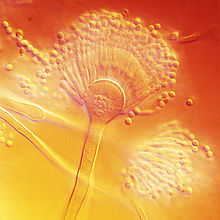Aspergillus terreus
| Aspergillus terreus | |
|---|---|
 |
|
| Scientific classification | |
| Kingdom: | Fungi |
| Division: | Ascomycota |
| Class: | Eurotiomycetes |
| Order: | Eurotiales |
| Family: | Trichocomaceae |
| Genus: | Aspergillus |
| Species: | A. terreus |
| Binomial name | |
|
Aspergillus terreus Thom (1918) |
|
Aspergillus terreus, also known as Aspergillus terrestris, is a fungus (mold) found worldwide in soil. Although thought to be strictly asexual until recently, A. terreus is now known to be capable of sexual reproduction. This saprotrophic fungus is prevalent in warmer climates such as tropical and subtropical regions. Aside from being located in soil, A. terreus has also been found in habitats such as decomposing vegetation and dust.A. terreus is commonly used in industry to produce important organic acids, such as itaconic acid and cis-aconitic acid, as well as enzymes, like xylanase. It was also the initial source for the drug mevinolin (lovastatin), a drug for lowering serum cholesterol.
A. terreus can cause opportunistic infection in people with deficient immune systems. It is relatively resistant to amphotericin B, a common antifungal drug.Aspergillus terreus also produces aspterric acid and 6-hydroxymellein, inhibitors of pollen development in Arabidopsis thaliana.
A. terreus is brownish in colour and gets darker as it ages on culture media. On Czapek or malt extract agar (MEA) medium at 25 °C (77 °F), colonies have the conditions to grow rapidly and have smooth-like walls. In some cases, they are able to become floccose, achieving hair-like soft tufts. Colonies on malt extract agar grow faster and sporulate more densely than on many other media.
A. terreus has conidial heads that are compact, biseriate, and densely columnar, reaching 500 × 30–50 µm in diameter. Conidiophores of A. terreus are smooth and hyaline up to 100–250 × 4–6 µm in diameter. The conidia of A. terreus are small, about 2 µm in diameter, globose-shaped, smooth-walled, and can vary from light yellow to hyaline. Unique to this species is the production of aleurioconidia, asexual spores produced directly on the hyphae that are larger than the phialoconidia (e.g. 6–7 µm in diameter). This structure might be influential in the way A. terreus presents itself clinically as it can induce elevated inflammatory responses.
...
Wikipedia
